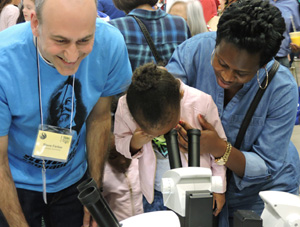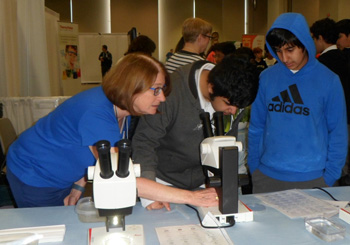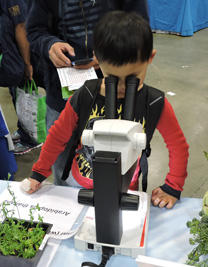Developmental biology at the 4th USA Science &
Engineering Festival
By Marsha Lucas
Developing zebrafish, Xenopus, and
Arabidopsis were highlights of the
Society for
Developmental Biology exhibit at the
4th USA Science
& Engineering Festival held April 15-17, 2016 in
Washington, DC. More than 365,000 people attended
the biennial festival with nearly 630 exhibitors
from government, industry, academia, and
professional societies.
|
 |
|
Steven Farber (left) showing the zebrafish |
SDB partnered with
BioEYES and the
Carnegie
Institution for Science to bring developing
zebrafish embryos to the festival.
Steven Farber of
the Carnegie Institution for Science and co-creator
of BioEYES shared how scientists study zebrafish
development as a model for human development and
diseases. Visitors learned how to distinguish male
and female adult fish, observed cleavage through
larval stages of development, and visualized the
beating heart and circulating red blood cells.
|
 |
|
Sally Moody helping with Xenopus |
Sally Moody of George Washington University brought
Xenopus embryos and tadpoles to the festival.
Visitors were able to observe changes over the first
few weeks of development, visualize the beating
heart, and watch tadpoles swimming around in their
dish. Many were surprised by how small and
transparent the Xenopus tadpoles were compared to
the much larger and opaque tadpoles they see in
their neighborhood ponds.
|
 |
|
Child viewing an Arabidopsis flower |
The third exhibit focused on the diversity of
Brassica oleracea and how changes in developmental
genes are what give broccoli, cauliflower, Brussels
sprouts, cabbage, and kale their phenotypic
variation. Attendees learned that a mutation in the
CAULIFLOWER gene—originally identified in
Arabidopsis—is what gives broccoli and cauliflower
its appearance.
Zhongchi Liu of the University of
Maryland provided Arabidopsis plants for them to
visualize wildtype flowers and cauliflower mutants
which fail to make flowers. Volunteers
emphasized the connection between
research on model plants like Arabidopsis and its
relevance to agriculture and the foods that we eat. This exercise was part of the
Evolution Thought Trail—a group of ten exhibitors
with evolution themed exhibits across multiple
scientific disciplines.
The enthusiastic participation of some forty-six
volunteers over the three-day event made SDB’s
exhibit a complete success. Graduate students,
postdocs, and faculty members traveled from DC,
Maryland, Virginia, and even Massachusetts to help
out. Additionally, BioEYES staff, local teachers and
middle school and high school students joyfully
shared the beauty of developmental biology with the
public.
Outreach activities like this raise public awareness
about science’s contributions to improving our daily
life, making new discoveries, and improving the country’s economy. As
the festival’s founder, Larry Bock (recipient of
SDB
2012 Viktor Hamburger Outstanding Educator Prize)
put it: It is time for us to celebrate science and
scientists as we do with sports and media
celebrities. And this is such a celebration!
|